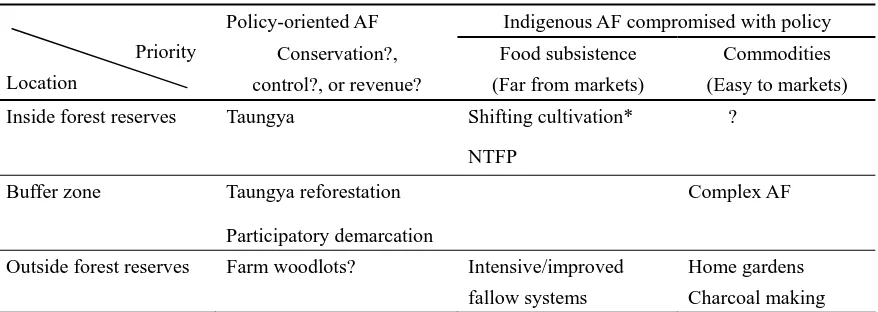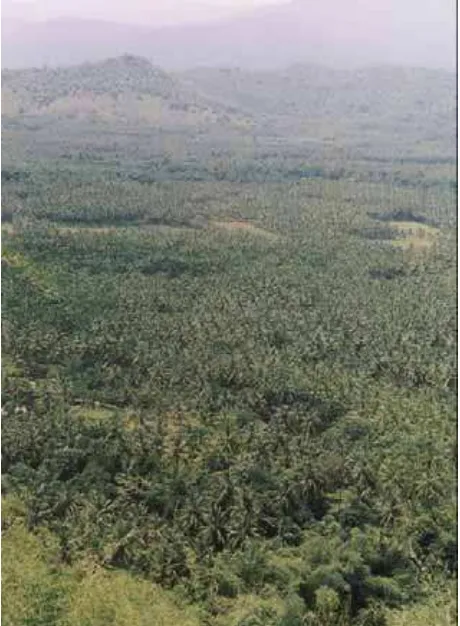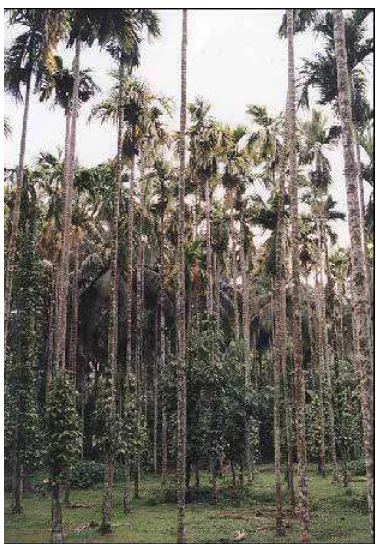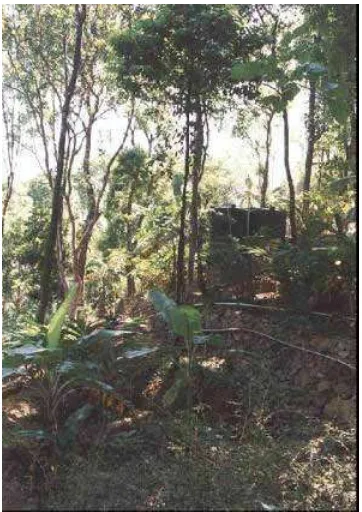OIKAWA Yosei
1. General practice of agroforestry
Agroforestry is a term defined as “the cultivation of trees or other woody plants with crops or pasture for multiple benefits” (Buck et al, 1999). If we deal with Asian farming systems, it might be better to expand the definition to include livestock, poultry, and fishes.
A large number of studies have been made on advantages of agroforestry including forest management issues that we are discussing in this report, but we do not have a clear understanding of the disadvantages. In this chapter, therefore, based on field trips to Ghana, India and Indonesia, and literature review on forest management in these countries, I briefly discussed potentialities of agroforestry in three different locations: inside forest reserves, border zone, and outside forest reserves by focusing on the disadvantages of agroforestry.
1.1. Agroforestry inside forest reserves
Forest reserves may be divided into two patterns by distribution: forest reserves surrounded by villages, and forest reserves relatively inland and enclosing villages.
The former is seen in Java, where intercropping or Taungya system has been widely adopted as a tool for the establishment of plantations inside state forests. Since state forests are surrounded by villages in many cases, this system is expected to function as a buffer that provides food or additional income sources for the villagers. The main problem of the system seems to be that villagers cannot continuously cultivate food crops in plantation / agroforestry plots. Before canopy closure, the cultivators must shift their cultivation plots to the next site, as they are migrant workers. Timber trees do not belong to the cultivators but states. Recently, community forestry programs have been improved so that cultivators and the state can share the profits from forests. Species planted in the system include fruit and fodder species in order to support farmers’ requirements. Timber species that directly contribute to revenues are more preferred by states. However, if states and forest people start harvest sharing, it might enhance the cultivators’ awareness and guarantee conservation for the long term.
The latter is inland. Although many governments prohibit shifting cultivation, local people earn their livelihoods by shifting cultivation. For shifting cultivators under short fallow systems inside the reserves, improved fallow systems or alley cropping may be effective to sustain soil fertility and productivity. Field experiments for interior people in various countries, however, did not always show positive results.
Ghanaian pioneer cacao cultivators have expanded their cacao agroforestry inside forest reserves. It may be also regarded as a cacao plantation with natural shade trees. Such a case needs to be reviewed for the future management system including devolution or privatization. As Otsuka and Place (2001) examined in western Ghana, we need to explore more suitable land management by understanding evolution of inheritance systems in the areas where agroforestry is implemented.
1.2. Agroforestry in buffer zone
Even near forest boundaries, Taungya agroforestry is suitable for reforestation after clear cutting and reforestation since villagers easily access the sites. Some farmers want to cultivate annual and perennial cash crops, other farmers more food crops. The above problem of Taungya would come if they lost such buffer lands after canopy closure.
To coordinate villagers’ needs and state responsibilities towards villagers, participatory demarcation is recommended.
Several case studies in Sumatra and Kalimantan of Indonesia and Kerala of India have shown that complex agroforestry systems or forest gardens are potential as a buffer zone (Michon et al, 1986 Salafsky, 1994; Murniati et al, 2001; Moench, 1991). In these systems, land use evolution from slash-and-burn agriculture to forest gardens is expected to sustain the production and environment. In these (relatively) successful cases, all commodities from forest gardens, such as clove, cinnamon, Damar (Shorea javanica), rubber, durian, and other tropical fruits, have been transported to local or international markets by merchants. Thus, it is obvious that marketing is one of the key factors to support the evolution of agroforestry systems. If there is no market in the area, the number of commodities is small; farmers will rarely develop their forest gardens. In such condition, food crops and short-term crops are farmers’ concern.
1.3. Agroforestry outside forest reserves
In many countries, farmers have already started to grow trees for their livelihood and commercial purposes (Arnold & Dewees, 1995). There are many opportunities to intervene or compromise farm woodlots (community forests), alley cropping, home gardens, and so on. During our visited to Ghana in August 2001, we found teak farm woodlots in many hamlets. The woodlots seemed to be abandoned. If forestry extension services provide appropriate technical and socio-economic supports to local people, such woodlots are also managed sustainably.
For poor farmers living far from markets need to produce more food in infertile land, agricultural intensification or improvement is urgent. For shifting cultivators, I recommend intensive fallow or improved fallow using leguminous shrubs, trees, or cover crops, rather than mixed (fruit) gardens / complex agroforestry supported by markets.
result in deforestation and over-cutting in village areas. In such situation, any forms of tree and woody plants growing might reduce illegal cutting in forest reserves. Charcoal making and its applications for sustainable agriculture would reduce application of agricultural chemicals. Finally, I attempted to summarize potentiality of agroforestry in Table 8.1.
Table 8.1. Summary: Potentiality of agroforestry activities by location
Policy-oriented AF Indigenous AF compromised with policy
Priority Location
Conservation?, control?, or revenue?
Food subsistence (Far from markets)
Commodities (Easy to markets)
Shifting cultivation* ? Inside forest reserves Taungya
NTFP
Taungya reforestation Complex AF
Buffer zone
Participatory demarcation
Outside forest reserves Farm woodlots? Intensive/improved fallow systems
Home gardens Charcoal making
Note: * The author recognizes shifting cultivation as an indigenous agroforestry system.
1.4. Policy implication
For appropriate implementation of agroforestry in different country, it is necessary to understand 1) successful and unsuccessful agroforestry systems, and 2) existing farming systems which can be improved with woody components. Through this review, however, it was difficult to list references on disadvantage of agroforestry. This might be caused by the attitude of scientists, officers, and NGO workers who rarely criticize agroforestry projects. During field surveys, we sometimes hear and observe failures and problems of agroforestry practices. Mazane (2003) has reviewed that mismanagement of commercial oriented social forestry and Joint Forest Management (JFM) in India may accelerate disparity in wealth. Whenever we study agroforestry for better land management, criticism from social and economic viewpoints is essential to implement agroforestry programs carefully and successfully.
2. Distribution and utilization of trees outside forest reserves: Overview of Kerala
As the word “Kerala” is derived from kera (coconut) in Malayalam, we find a lot of coconut palms in Kerala State, especially in the lowlands. In this section, I overview the distribution and utilization of trees outside forest reserve to prospect tree-oriented land uses in the counties where devolution or privatization in forest management is going on.
2.1. Major findings through literature survey and field visits
[image:4.595.73.322.267.422.2]Unlike the official statistics shown in Table 8.2, we observed much more tree-oriented landscapes during the field trips (Figure 8. 1). Although “land under miscellaneous tree crops” accounts only for 0.13 percent in this table, Kerala is known as a region where homegardens and related agroforestry systems are well-developed (Figure 8.2). Many scholars have studied homegardens, intercropped rubber gardens, and successional agroforestry systems (Nair & Sreedharan, 1986; Jose & Shanmugaratnam, 1993; Kumar et al, 1994; Rajasekharan & Veeraputhran, 2002; Moench 1991). We could also observe various kinds of agroforestry systems during the field trips as shown in the following Figures.
Table 8.2. Land use pattern in Kerala 2002-03
Land use type Percentage Forest 27.83 Land put non-agricultural uses 9.70 Barren and uncultivated land 0.77 Permanent pastures & grazing land 0.01 Land under miscellaneous tree crops 0.13
Cultivable waste 1.93
Fallow other than current fallow 1.07 Current fallow
Net area sown
1.81 56.74
Source: Department of Planning & Economic Affairs (2004)
F igure 8.1. Coconut garden view from the hillside between Nilambur and Nilgiri
[image:4.595.76.306.447.760.2]F igure 8.2. A homegarden in a village between Thrissur and Ernakulam, Kerala
Source: Author (March 2004)
F igure 8.3. An organic mixed homegarden in a village near Peechi
Source: Author (September 2002)
F igure 8.4. A conventional betel-pepper homegarden in a village near Peechi
[image:5.595.83.539.80.759.2] [image:5.595.87.318.92.576.2] [image:5.595.336.524.498.770.2]F igure 8.5. Rubber-pineapple agroforestry near Muvattupuzha
Source: Author (February 2004)
F igure 8.6. Conversion from paddy fields into coconut gardens, on the way from Thrissur to Nilambur
Source: Author (September 2002)
F igure 8.7. Herb garden under shade: Crops are supplied with water pumped in PDS, Peermade
[image:6.595.73.341.96.280.2] [image:6.595.245.509.309.494.2] [image:6.595.70.251.509.765.2]2.2. E volution of homegardens
In September 2002, Dr. S. Sankar at Kerala Forestry Research Institute in Peechi took us to a village covered with homegardens near the Institute. The village was formed in a part of state forests in 1970’s when the state land reform was implemented. Transformation from state forests into agroforest villages seems to have been widely observed in Kerala, as described by Chundamannil (1988).
“While forest clearance in the pre-war years was for the creation of large-scale monoculture plantations of tea, cardamom, rubber and teak, the latter is characterized by small-holder food production, very soon stabilising into the traditional multiple species home gardens or small rubber holdings.” (Chundamannil, 1988: p.237)
Dr. Sankar explained two typical managements of homegardens: organic and conventional. Figure 8.3 shows a mixed-cropped homegarden under organic management. Every rainy season, farmers dig holes near the coconut trees, and fallen leaves are put into the holes. In the dry season, they cover the holes with soil to reduce evaporation. Figure 8.4 shows a Betel-pepper homegarden under conventional management. Agricultural chemicals are commonly used in the garden. Both betel and pepper were damaged by diseases at that time.
2.3. Conversion from paddy to banana and coconut gardens
Figure 8.5 was taken on the roadside from Thrissur to Nilambur. We understood that low prices of rice caused planting of banana and coconut palm in this area. The state statistics from 1975-76 to 1995-96 shows that cultivated areas of rice and tapioca decreased; of pepper, coconut, coffee, and rubber increased (Department of Economics and Statistics in Mahesh, 1999). Mahesh (1999) has discussed price factors affecting recent land use changes.
“The trend in the comparative prices of agricultural products and wages had the effect of shifting to crops requiring lower labor input.” (Mahesh, 1999: pp.48) “From experience, they have found that in the long run coconut is a more reliable and useful crop responding favorably to manuring and irrigation. Income from coconut gardens could be augmented by raising various other crops like banana, tubers, pepper etc as inter-crops. The farmers therefore prefer coconut cultivation with inter-cropping to all other crops.” (Mahesh, 1999: pp.49)
2.4. Rubber agroforestry
Figure 8.6 shows an example of rubber-pineapple agroforestry near Muvattupuzha. Coconut-pineapple agroforestry was also observed in the same place. While coconut agroforestry can be continued to intercrop, rubber agroforestry might be intercropped until canopy closure. After canopy closure, combination with other crops such as shade-tolerant medicinal herbs and root crops may support household economy of small farmers.
2.5. Agro-silvo-pastoral combination
In February 2004, Dr. B.M. Kumar took me to Livestock Research Station of Kerala Agricultural University, which has developed its mixed-farming system including agroforestry. The 163 ha consists of 70 ha of pasture, 22 ha of cultivated grass, 32 ha of natural forest, 24 ha of forest plantation, 8 ha of agroforestry, and the rest of road area. Manure from cowsheds was utilized for cultivation of crops and grasses. Coconut-grass agroforestry and Gliricidia (and other pole trees)-pepper agroforestry were observed. These were set up for demonstrations and experiments, but their organic products support operating expenses of the university.
2.6. Integrated resource use
Integrated Rural Technology Centre (IRTC) under Kerala Sasthra Sahithya Parishad (KSSP), an active NGO in Kerala, was surrounded by various useful trees. The center provides various extension and training courses for local people, not only in agricultural field but also in rural industrial and development fields such as soap making, biomass gas, and panchayath resource mapping. As promoted by many NGOs including this institute and PDS in the following, vermiculture or vermicomposting seems to be getting popular among farmers in India and other tropical countries. This might be applied in agroforestry systems and organic farming.
2.7. Towards rural development
Acknowledgement
I wish express my gratitude to Dr. B. Mohan Kumar at Kerala Agricultural University, and all the staffs of Kerala Forestry Research Institute, Integrated Rural Technology Centre, Peermade Development Society, and Periyar Tiger Reserve, who kindly guided us in each institution.
References
Arnold, J. E. M., and P. E. Dewees (eds.), 1995. Tree management in farmer strategies: Responses to agricultural
intensification. Oxford University Press, Oxford. 292pp.
Buck, L. E., J. P. Lassoie, and E. C. M. Fernandes (eds.), 1999. Preface. In Agroforestry in sustainable agricultural
systems. CRC Press, Boca Raton. 416pp.
Chundamannil, M., 1988. Forest land use policy and the conservation intent in Kerala, India. In Dargavel, John, Kay Dixon and Noel Semple (eds.), Changing Tropical Forests, pp.231-245. Centre for Resource and Environmental Studies, ANU, Canberra. 446pp.
Department of Planning & Economic Affairs, 2004. Economic Review 2004. In the Website of Government of Kerala, http://www.kerala.gov.in/dept_planning/ecoreview1.htm.
George, P.S., and S. Chattopadhyay, 2001. Population and land use in Kerala. In Indian National Science Academy, Chinese Academy of Sciences, and U.S. National Academy of Sciences (eds.), Growing Populations, Changing
Landscapes: Studies from India, China, and the United States, pp.79-105. National Academy Press, Washington
D.C. 299pp.
Jose, D. and S. Shanmugaratnam, 1993. Traditional homegardens of Kerala: A sustainable human ecosystem.
Agroforestry Systems, 24, 203-213.
Kumar, B. M., S. J. George, and S. Chinnamani, 1994. Diversity, structure and standing stock of wood in the homegardens of Kerala in peninsular India. Agroforestry Systems, 25, 243-262.
Mahesh, R. 1999. Causes and consequences of change in cropping pattern: A location-specific study. In Discussion
Paper No.11, Thiruvananthapuram: Kerala Research Program on Local Level Development, Centre for
Development Studies. 56pp.
Mazane, K. 2003. Development and Environment: Indian Indigenous People’s seeking the alternative (Kaihatsu-to-Kankyo: Indo-senjuu-minzoku, mouhitotsu-no sentakushi-o Motomete). Sekai-shiso-sha, Tokyo. 193pp. In Japanese.
Michon, G., F. Mary, and J. Bompard, 1986. Multistoried agroforestry garden system in West Sumatra, Indonesia.
Agroforestry Systems, 4, 315-338.
Moench, M., 1991. Soil erosion under a successional agroforestry sequence: a case study from Idukki District, Kerala, India. Agroforestry Systems, 15, 31-50.
Murniati, Garrity D. P., Gintings A. N., 2001. The contribution of agroforestry systems to reducing farmers' dependence on the resources of adjacent national parks: a case study from Sumatra, Indonesia. Agroforestry Systems, 52, 171-183.
Nair, M. A. and C. Sreedharan, 1986. Agroforestry farming systems in the homesteads of Kerala, Southern India.
Agroforestry Systems, 4, 339-363.
Otsuka, K. and F. Place (eds.), 2001. Land tenure and natural resource management. The Johns Hopkins University Press, Baltimore. 389pp.
Rajasekharan, P. and S. Veeraputhran, 2002. Adoption of intercropping in rubber smallholdings in Kerala, India: a tobit analysis. Agroforestry Systems, 56, 1-11.



